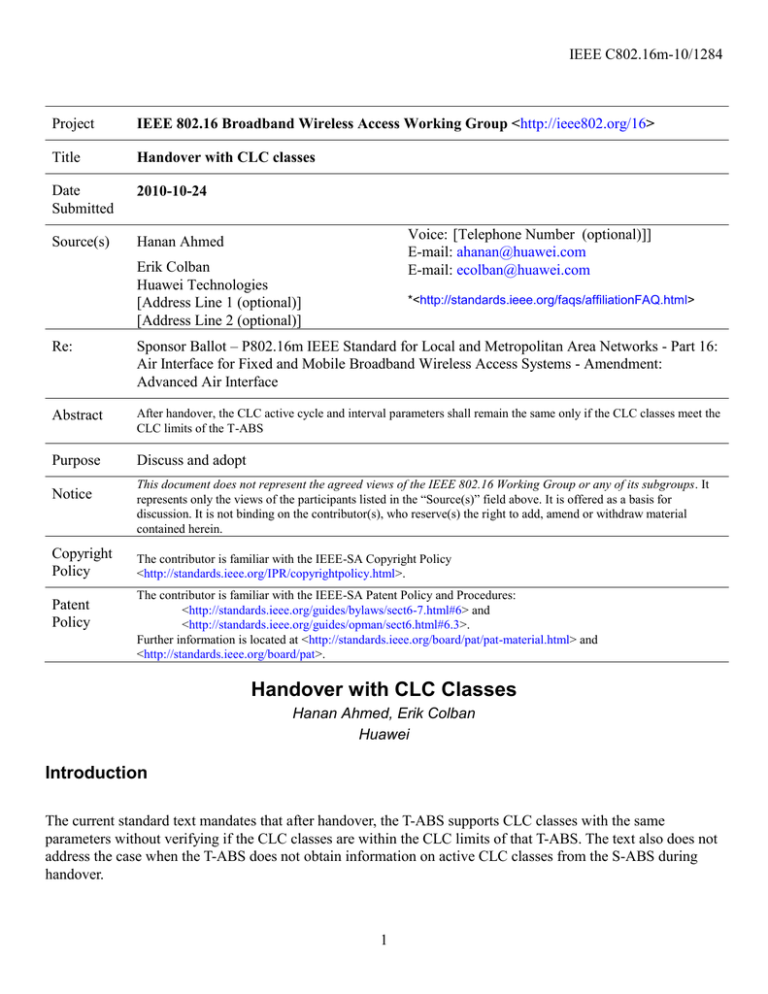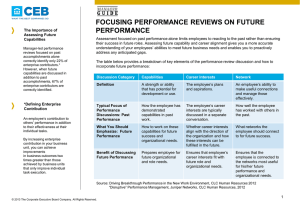IEEE C802.16m-10/1284 Project Title
advertisement

IEEE C802.16m-10/1284 Project IEEE 802.16 Broadband Wireless Access Working Group <http://ieee802.org/16> Title Handover with CLC classes Date Submitted 2010-10-24 Source(s) Hanan Ahmed Voice: [Telephone Number (optional)]] E-mail: ahanan@huawei.com E-mail: ecolban@huawei.com Erik Colban Huawei Technologies [Address Line 1 (optional)] [Address Line 2 (optional)] *<http://standards.ieee.org/faqs/affiliationFAQ.html> Re: Sponsor Ballot – P802.16m IEEE Standard for Local and Metropolitan Area Networks - Part 16: Air Interface for Fixed and Mobile Broadband Wireless Access Systems - Amendment: Advanced Air Interface Abstract After handover, the CLC active cycle and interval parameters shall remain the same only if the CLC classes meet the CLC limits of the T-ABS Purpose Discuss and adopt Notice Copyright Policy Patent Policy This document does not represent the agreed views of the IEEE 802.16 Working Group or any of its subgroups. It represents only the views of the participants listed in the “Source(s)” field above. It is offered as a basis for discussion. It is not binding on the contributor(s), who reserve(s) the right to add, amend or withdraw material contained herein. The contributor is familiar with the IEEE-SA Copyright Policy <http://standards.ieee.org/IPR/copyrightpolicy.html>. The contributor is familiar with the IEEE-SA Patent Policy and Procedures: <http://standards.ieee.org/guides/bylaws/sect6-7.html#6> and <http://standards.ieee.org/guides/opman/sect6.html#6.3>. Further information is located at <http://standards.ieee.org/board/pat/pat-material.html> and <http://standards.ieee.org/board/pat>. Handover with CLC Classes Hanan Ahmed, Erik Colban Huawei Introduction The current standard text mandates that after handover, the T-ABS supports CLC classes with the same parameters without verifying if the CLC classes are within the CLC limits of that T-ABS. The text also does not address the case when the T-ABS does not obtain information on active CLC classes from the S-ABS during handover. 1 IEEE C802.16m-10/1284 Proposed Changes Change 1: On page 493, starting on line 1, modify the existing text as follows: The AMS shall locally terminate the active Type III CLC class at the Disconnect Time or upon transmission of AAI-HO-IND with code 0b10. The AMS shall also locally suspend all active Type I and II CLC classes at the Disconnect Time or upon transmission of AAI-HO-IND with code 0b10, and reactivate them with the new SABS. During HO preparation, the new ST-ABS may obtain information on active CLC classes from the S-ABS via backbone network. During network re-entry, the T-ABS may indicate in the AAI- RNG-RSP message which CLC classes will become active after the completion of network re-entry. If this information is not included in the AAI- RNG-RSP message received from the T-ABS, then the AMS may request the activation of CLC classes from the T-ABS by sending AAI_CLC_REQ message. The CLC active cycle and interval parameters shall remain the same after handover if the CLC class meets the CLC limits of the T-ABS. The new ST-ABS may set the Super Frame Number of the start time to the suggested value in CLC Request from the AMS in case of an uncoordinated handover, or to the beginning of the next CLC active cycle based on the information obtained from the previous S-ABS via the backbone network. For Type II class, the new S-ABS may set the Start Frame Index of the start time different from the value in the AMS's CLC Request or from the previous S-ABS. For Type I class, the new S-ABS shall keep the Start Frame Index the same as suggested by the AMS or obtained from the previous S-ABS. The ABS shall send the start time information to the AMS in AAI-RNG-RSP during network reentry for fast reactivation if the AMS supports CLC mode. The AMS and the S-ABS shall automatically reactivate the suspended CLC classes if the handover is cancelled. 2

